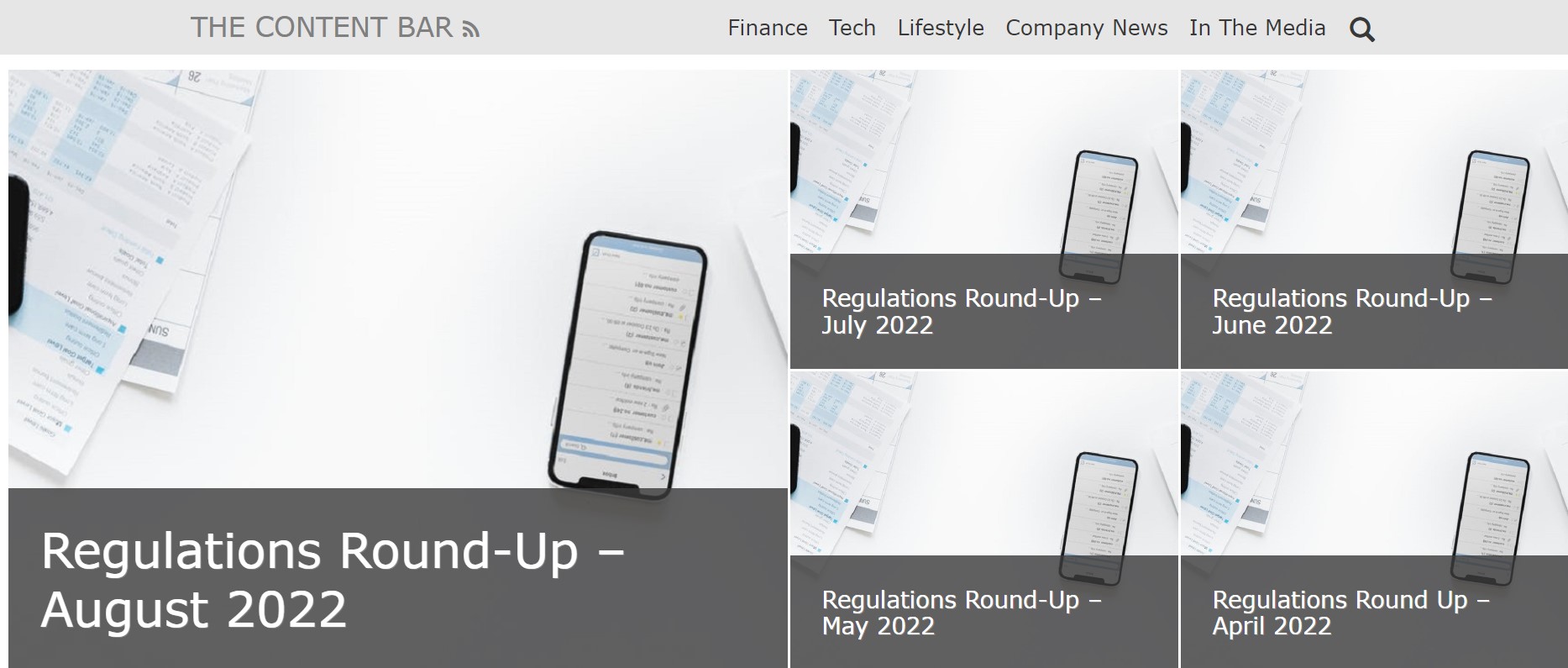The global financial services market is expected to grow from $23,319.52 billion in 2021 to $25,839.35 billion in 2022 at a compound annual growth rate of 10.8%. As a finance brand, what can you do to stand out in a tightly governed and highly competitive space? Join us as we check out 7 financial marketing challenges and how to overcome them.
#1 Pleasing the Regulators
First up for our financial marketing challenges is compliance. It’s no secret that there are loads of rules and regulations to follow within the finance space and breaking any of them could result in a hefty fine. To make things even more tricky, the rules are prone to change. So it’s crucial to keep up with the latest information from your regulatory body and never get complacent. At Contentworks, we offer a monthly Regulations Round-Up to help you stay in-the-know, so be sure to check back on a regular basis.

There are many ways to tighten up your marketing efforts and avoid landing in hot water. Firstly, make sure you know your regulatory body and follow the relevant legislation for your country/region. In the UK, nearly all financial service activities must be authorised by the FCA, whereas in Cyprus, CySEC takes control. Over in Australia, the Australian Securities and Investments Commission (ASIC) has its own set of rules. There are many common ground rules such as including warnings within your content and social media posts. You can read more on financial services social media rules from our Director Charlotte.

Don’t forget that each social media platform also has its own financial services rules and these must be fully understood. Facebook, for example, bans ads that promote financial products and services that are frequently associated with misleading or deceptive promotional practices. On the no-no list are initial coin offerings, binary options and contract for difference trading in addition to most crypto ads.
Our team of financial services content marketers can provide technical analysis, financial blogging and finance-focused social media. Compliance are not our enemies and we follow regulatory news and updates from ASIC, CySEC, MFSA, FCA, FSA, FRB, SEC, MiFID II and more.
#2 Brand Consistency
Consistent presentation of a brand has seen to increase revenue by 33%. Why? Because customers perceive consistent brand messaging and images as indicative of high quality. The problem with brand consistency is that many finance companies operate on a global scale with offices and operations around the world. Therefore, there’s a bunch of red tape that needs to be jumped over to ensure everyone works the same. Brand inconsistencies can also be caused by mismatched ideas, a lack of leadership, data management systems that differ from office to office and poor communication. In the finance space, they can also be caused by over enthusiastic IBs and partners creating their own marketing materials. We’ve seen logos adapted for various different countries, slogans changed and colours guessed. Largely this is down to the finance brand failing to provide approved marketing materials to maintain brand consistency.

Achieving Consistency in the Finance Space
One of the best ways to avoid inconsistencies is to create a set of documents that can be shared with your global team, partners and external agencies. Don’t know how to start? Our team can help you to create all these documents and structure management workshops to communicate key brand values.
- A detailed TOV (tone of voice) document to show tone, grammar rules and sentence structure
- A brand book to specify colours, logos, fonts and examples
- A strong vision and values statement with examples of how this translates in real life
- A content and social media strategy to provide direction, we recommend that this is updated yearly
- A PR strategy including crisis communication.
#3 Commoditisation
“Commoditize” refers to a process in which a product is essentially deemed identical to the same class of offering presented by a rival company. Commoditized products allow consumers to make purchasing decisions based solely on the price-tags of the item in question. As the cost of living rises, more consumers may prioritise price points. The problem with this is, you may end up in a race-to-the-bottom scenario as you battle competitors to the lowest price points. This is especially true in the banking sector.
What effect is commoditisation having on financial businesses – and how are they responding to it? That question was posed to a panel at Money20/20 Europe, with speakers represented companies ranging from UK enterprise software tech Sage to Western Union. No longer able to compete purely on price and often still lacking transparency on items such as fees, the onus is now on the longer-established institutions to put the ‘service’ back into financial services, or risk losing customers to the emerging challengers.
“Commoditisation is driving a lot of lower margins and less value, in what was something of a feeding frenzy and big pool for lots of players to feed from,”
Seamus Smith, CEO at Sage Pay
“If banks can no longer compete on price, what can they compete on?”
Tim Tynan, CEO of Bank of America Merchant Services
It’s a good question and one that we encourage our clients to address during our initial strategy meetings. Some of the ways you can compete without lowering prices include:
- Provide strong and responsive customer service across all channels
- Build a strong social media community that keeps investors and traders connected
- Offer free content, education and courses instead of discounts and bonuses
- Build a stronger brand than your competitors tailoring elements to your target demographic
- Watch your company culture and online reputation.
#4 Lack of Consumer Trust
According to a recent report, 60% of consumers say that trustworthiness and transparency are the most important traits of a brand, up from 55% in 2021. The problem in today’s corporate world is that business leaders often think consumers have more trust in a brand than they actually do which can leak to weak or complacent marketing. PwC’s latest survey, for example – The 2022 Consumer Intelligence Series Survey on Trust: New Net Currency for Business – found that 87% of the 503 US business executives surveyed in May believed that consumers ‘highly trust’ their companies. Just 30% of consumers, however, said they highly trust companies, a gap that a PwC representative described as ‘jarring.’ Great word.
Add this to the fact that only 60% of consumers trust brands with personal data and 21% of Americans don’t trust cryptocurrency at all and you can see that the finance space has some serious trust issues that need to be addressed through clever marketing.
Download our FREE eBook – Building Trust With Content – The Financial Services Marketing Guide

To close this gap in trust, you must firstly understand your audience. Do they see you as a reliable brand or are you making the same cringe-worthy mistake as other executives and overestimating your reputation? Send out email surveys and polls asking certain trust-related questions, gather the feedback and respond accordingly. Take note of reviews on relevant platforms. In the forex and finance space, brands are especially concerned about their online reputation. And they should be. This is a key differentiator between their own brand and their competitors.
#5 Rapidly Advancing Technology
One of the biggest challenges facing more established institutions is rapidly advancing technology. Fintech brands are literally bursting through doors armed with the latest platforms and software and it can be extremely difficult to keep up. There are currently a little over 8,000 MarTech solutions available worldwide, for example. This is the software marketers use to optimise their marketing efforts and achieve their objectives. It’s designed to meet the needs of today’s digital-first customers and can be highly beneficial. So what can you do to fend off the competition and avoid lagging way behind?
The easiest thing you can do to get in front of your target audience is to choose the right social media platforms. Research the facts so you don’t spend your marketing budget elsewhere. When you’re on the right platforms, you can then take advantage of all the marketing tools available to you such as ‘live’ communication, reels, video and more. The more socially savvy you are, the more engagement you should receive and this can be a game changer when it comes to brand awareness.
More brands are using TikTok to engage a younger audience. Be relevant, be snappy and be useful to make this work. Chime recently acknowledged the e-commerce extravaganza known as Prime Day with a TikTok contribution. Believe it or not, humour in finance can also get you over 233 thousand likes as Chime proved with their Friends tribute. Be sure to always use the right hashtags so that your content can be found and think carefully about what your demographic wants to see.

Another thing you can do is to identify the MarTech solutions that’ll most benefit you. This could include customer relationship management and automated email marketing solutions. Do your homework and make budget forecasts for each MarTech investment.
#6 Personalisation
62% of consumers expect personalisation, saying that a brand will lose their loyalty if their experience is not personalised. 49% will become repeat buyers if personalisation is offered. Personalisation is even more significant when it comes to financial services marketing. This is because customers expect financial brands to know them better because of all the data they collect. A lack of personalisation could therefore reinforce the data trust issues mentioned earlier in this article.
Financial service providers, however, struggle to personalise their service offerings. This is because they often tend to lack a single view of the customer. With little integration across channels, marketing efforts cannot compile cross-channel customer data and generate a 360-degree view of the customer. As such, hyper-personalisation becomes incredibly tricky.
Firstly, you need to work on the data collection process and this can be done through smoother and more effective marketing automation. Start by linking all marketing technology into a unified marketing stack to generate a single view of a customer. This will help you to identify and understand your customers in more detail. From there, use the data collected to segment your audience as this will allow you to generate campaigns and create tailor-made content for each segment.
#7 Hypercompetitive Environment
Last on our list of 7 Financial Marketing Challenges and How to Overcome Them, is the hypercompetitive environment. The finance sector continues to grow at a fast pace. In fact, there are now 473 fintech unicorns globally, with 40 added in Q1 2022. And that’s only fintechs. There are thousands of brokers and banks with new ones opening (and closing) each day! Innovation is pushing the industry forward day-by-day creating a hyper-competitive environment for finance brands. With technology advances, agile fintechs, app offerings, social media followings and more to consider, brands really need to focus on staying afloat or they risk sinking.
We work with forex brokers, banks, fintechs and investment firms to make sure their marketing gets them noticed. Here are some of the ways we do that:
- Unique branding and a winning TOV document
- Excellent web copy, education, blogs and whitepapers/eBooks
- Engaging videos that can sit on home pages or social media
- A solid keyword ranking strategy that is adhered to throughout all content
- Courses, webinars and online presentations
- A well stocked IB/ partner portal filled with usable resources
- Strategic social media marketing on the right channels
The finance space is highly competitive and challenging. Speak to Contentworks for tailored content marketing solutions that will get you noticed. Enjoyed reading 7 Financial Marketing Challenges and How to Overcome Them? Hit share!
